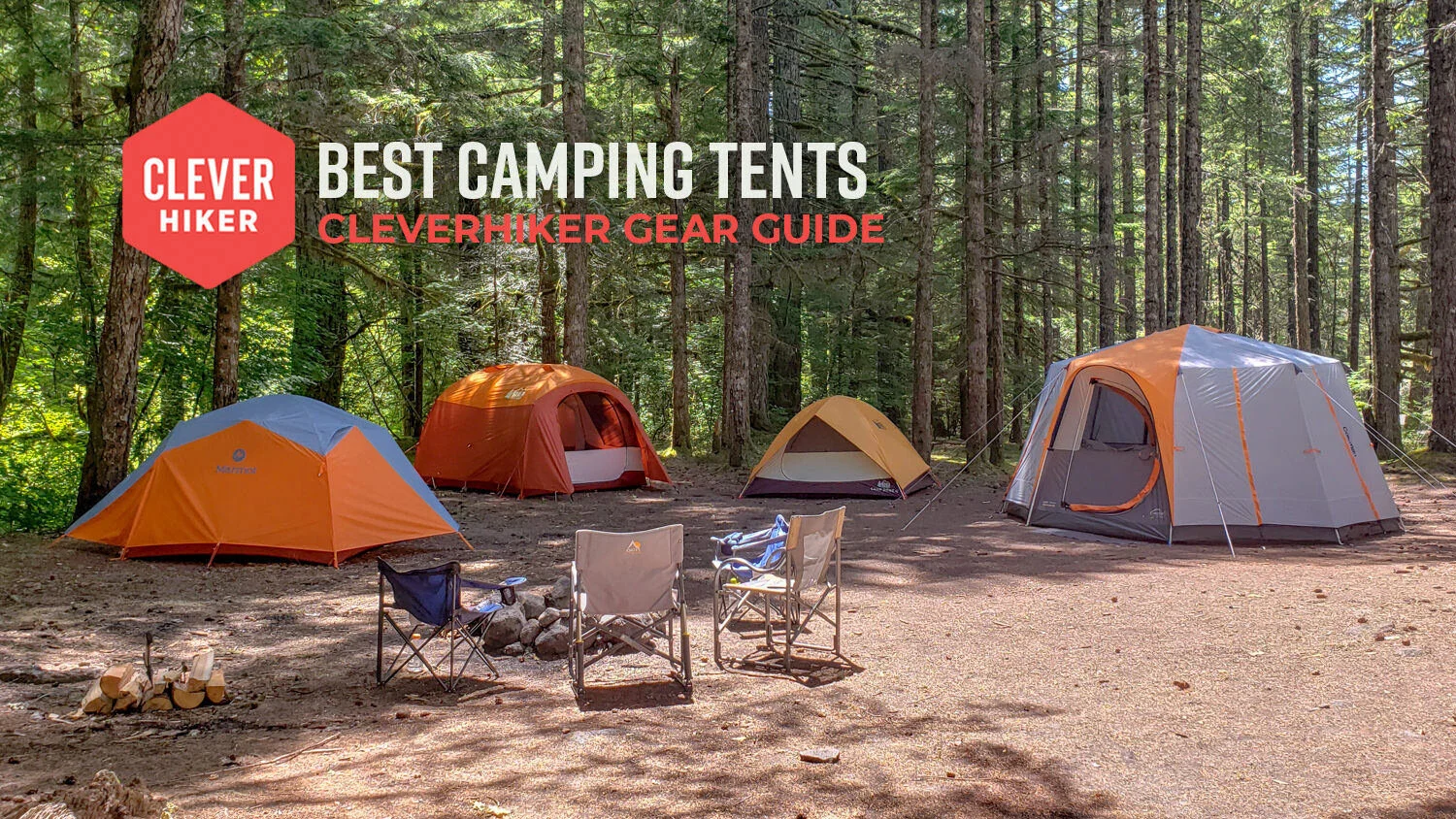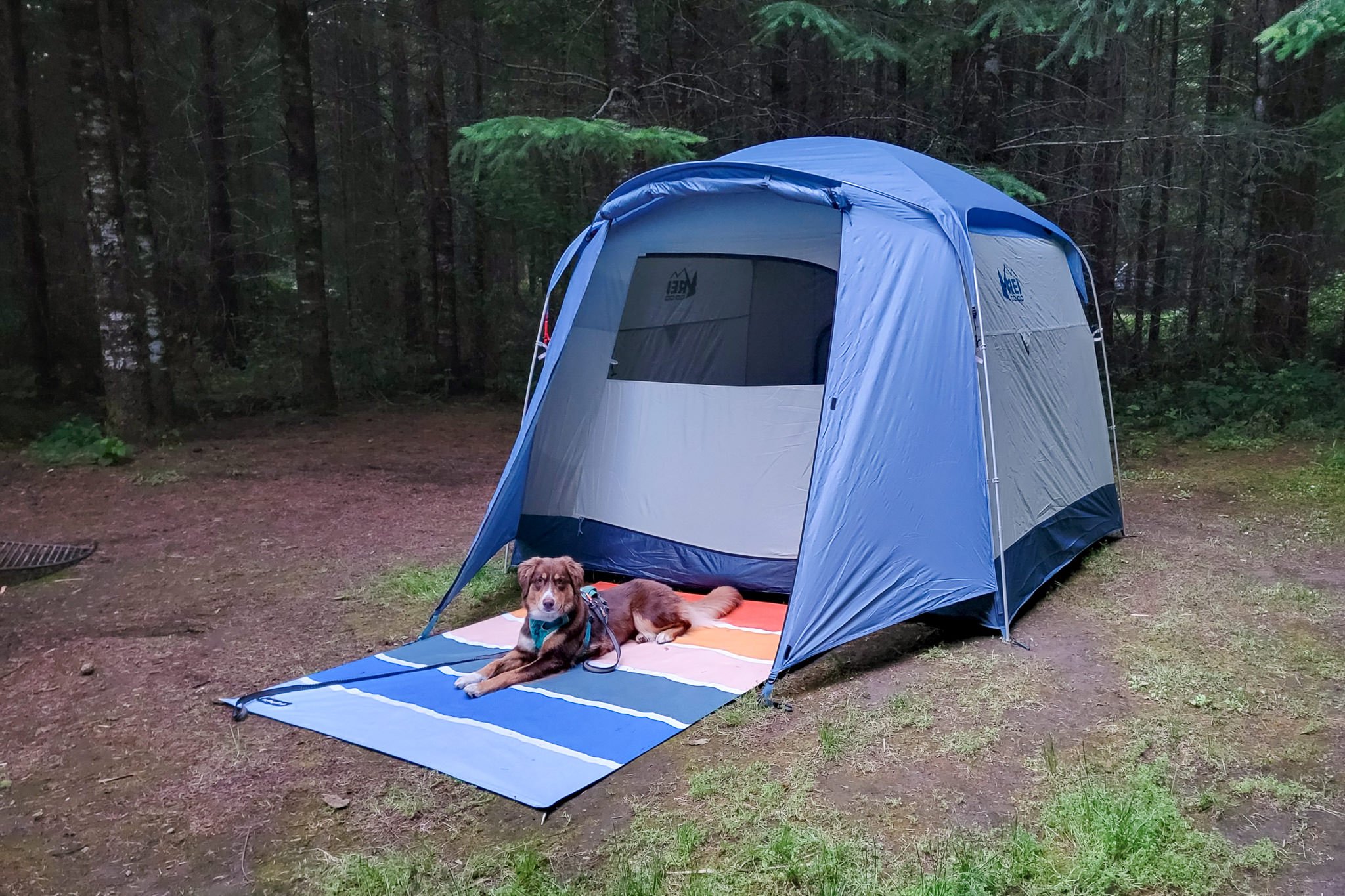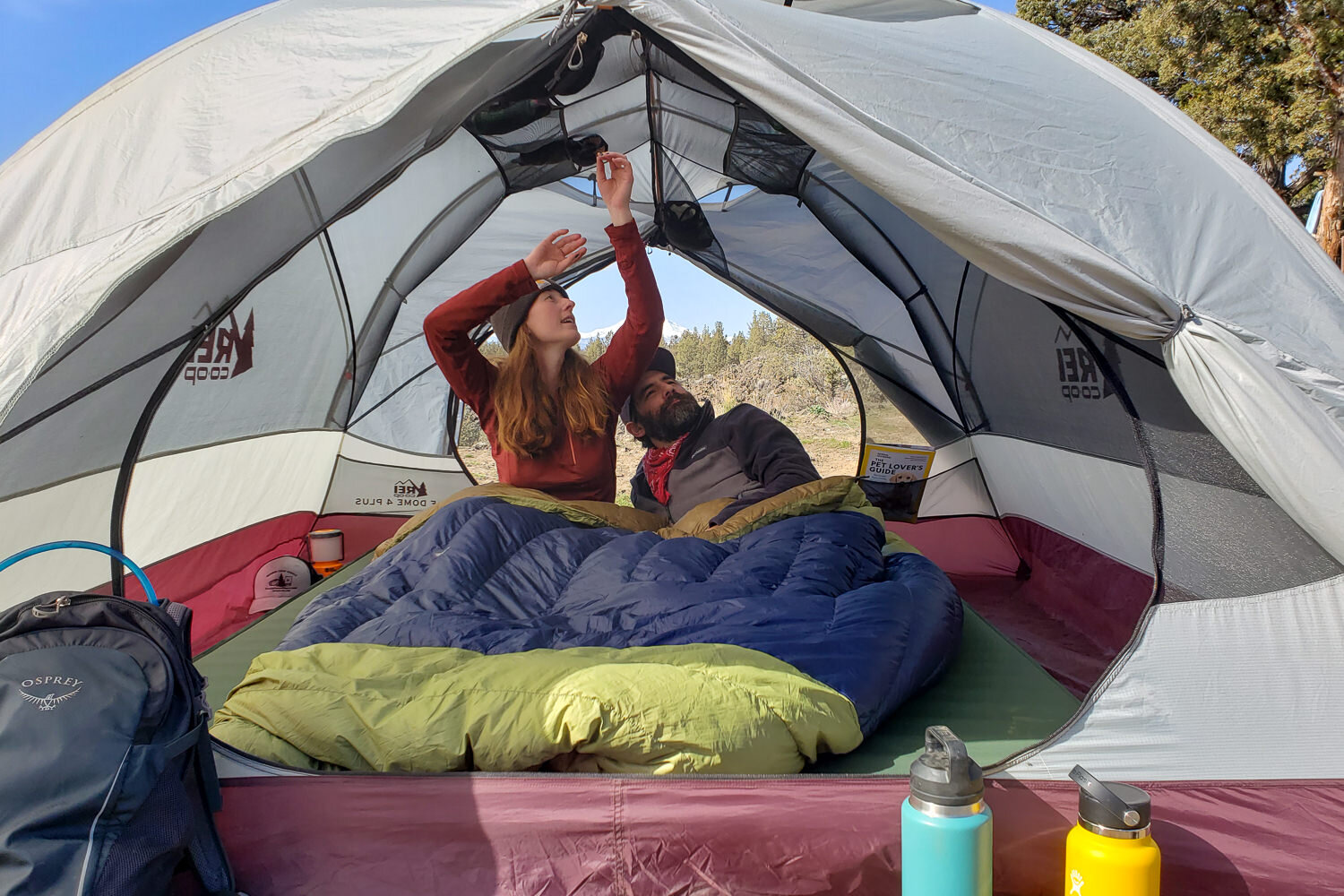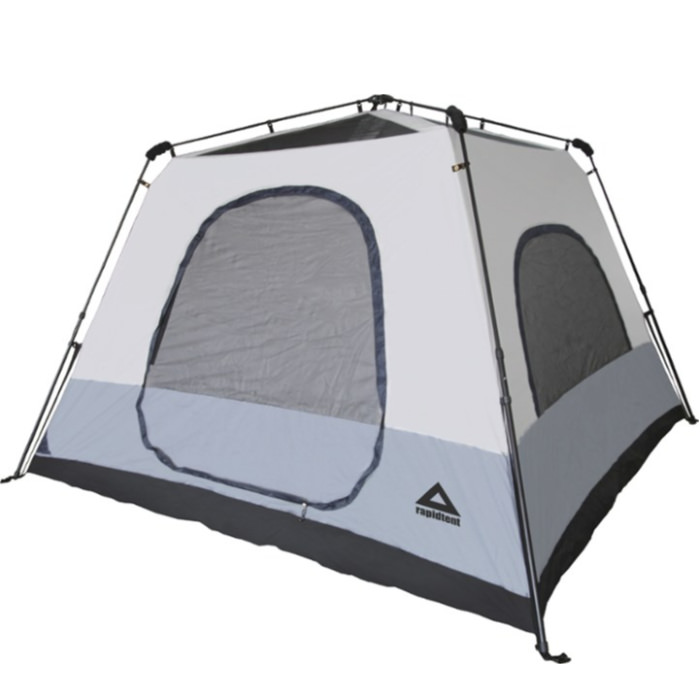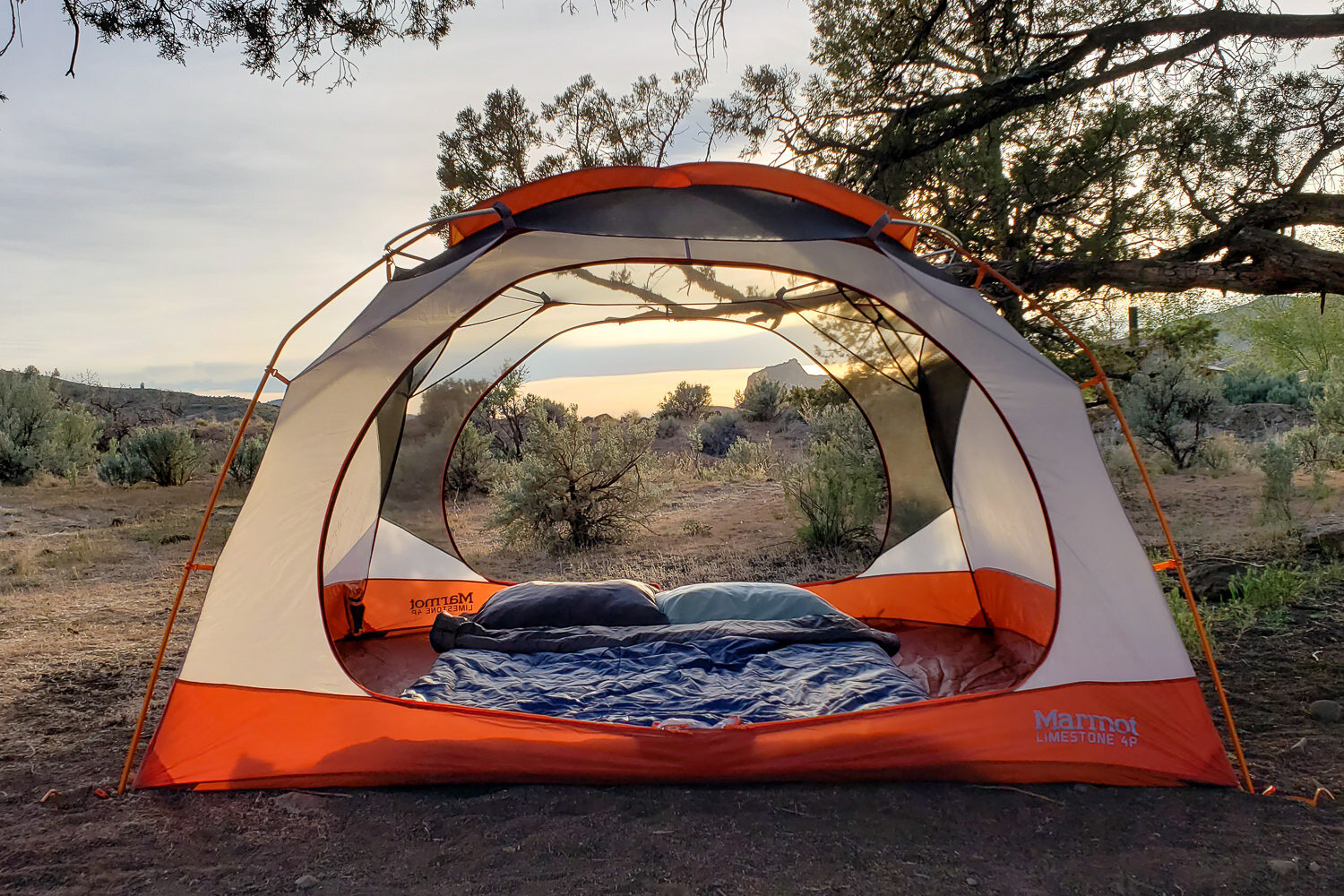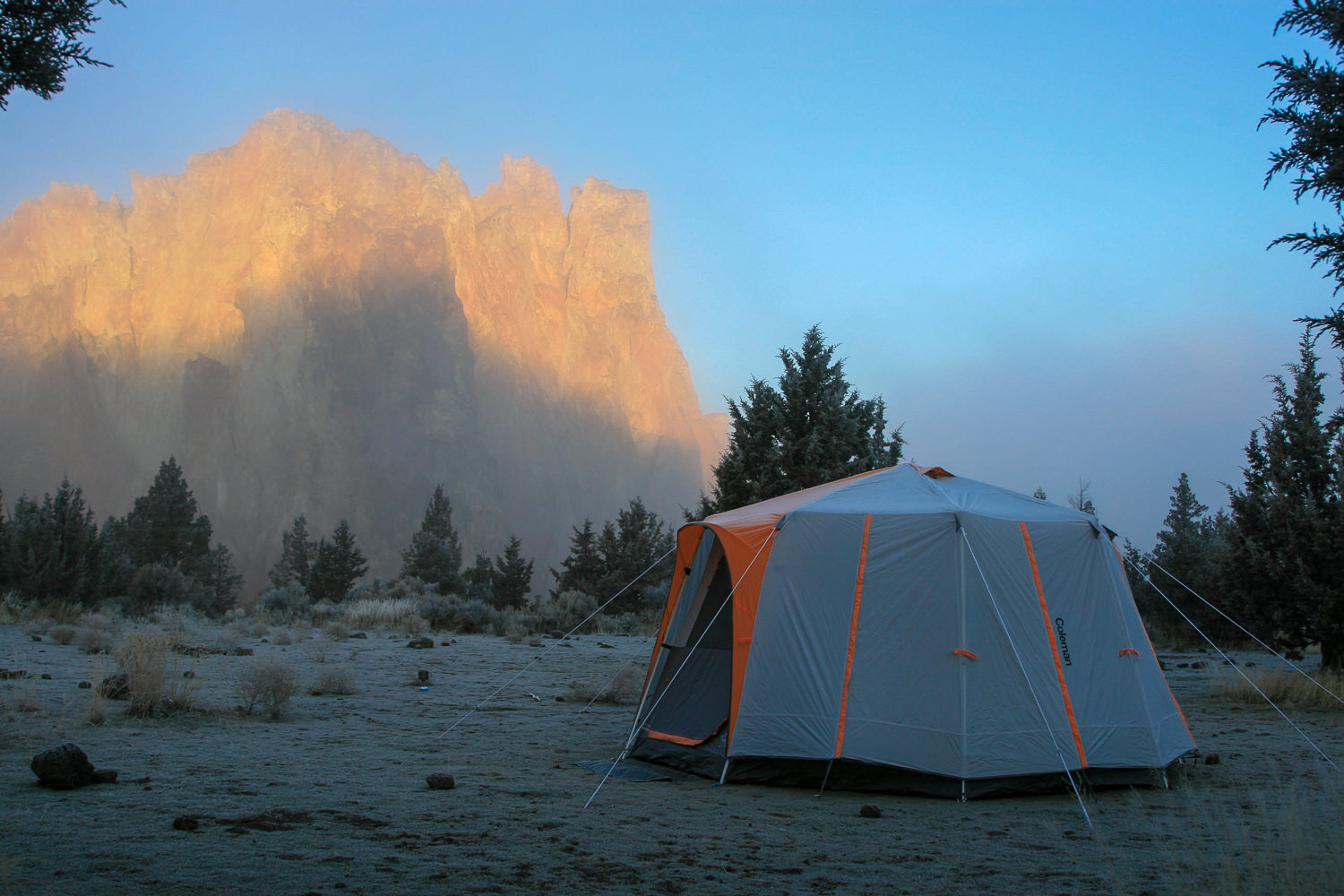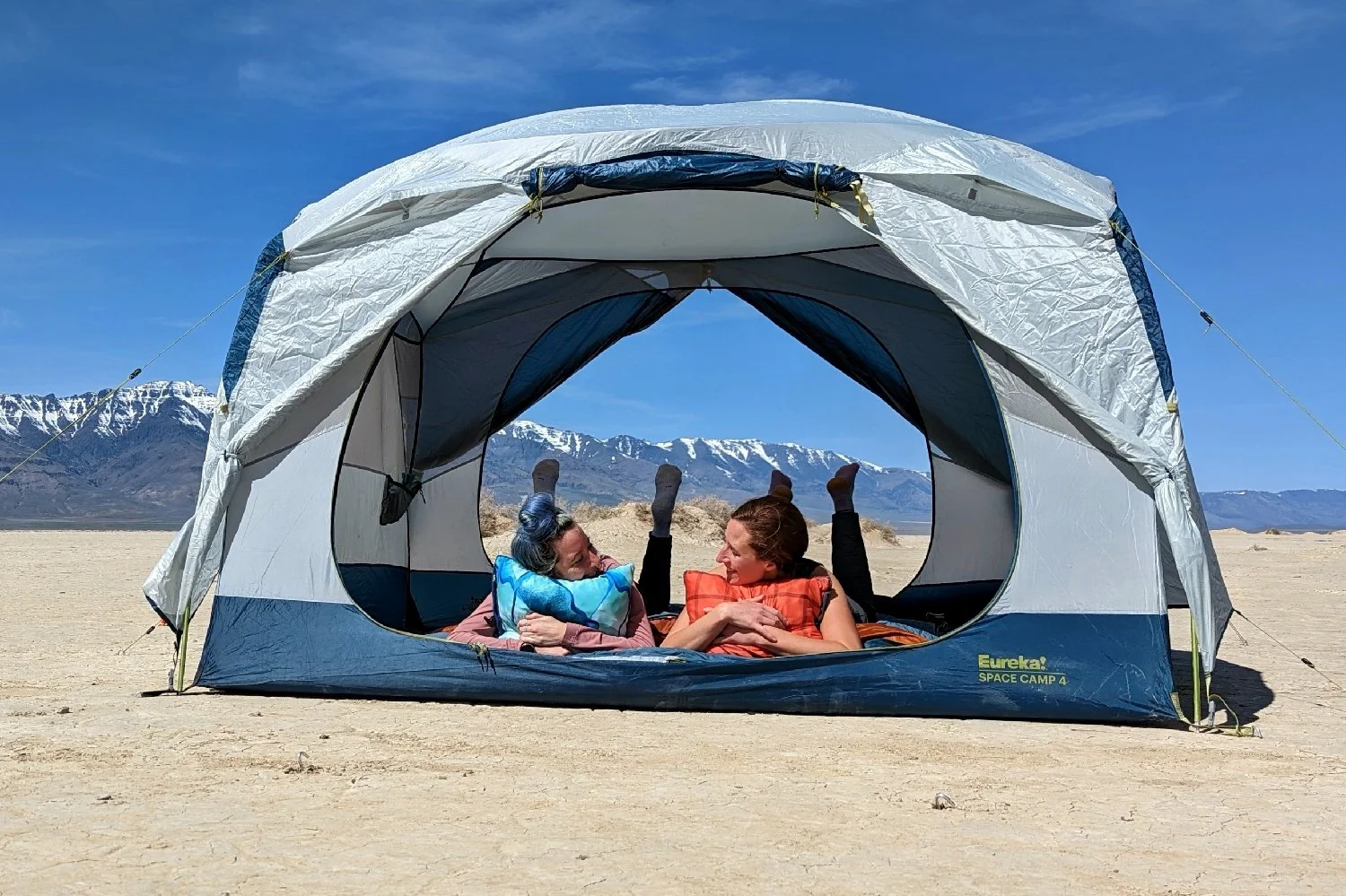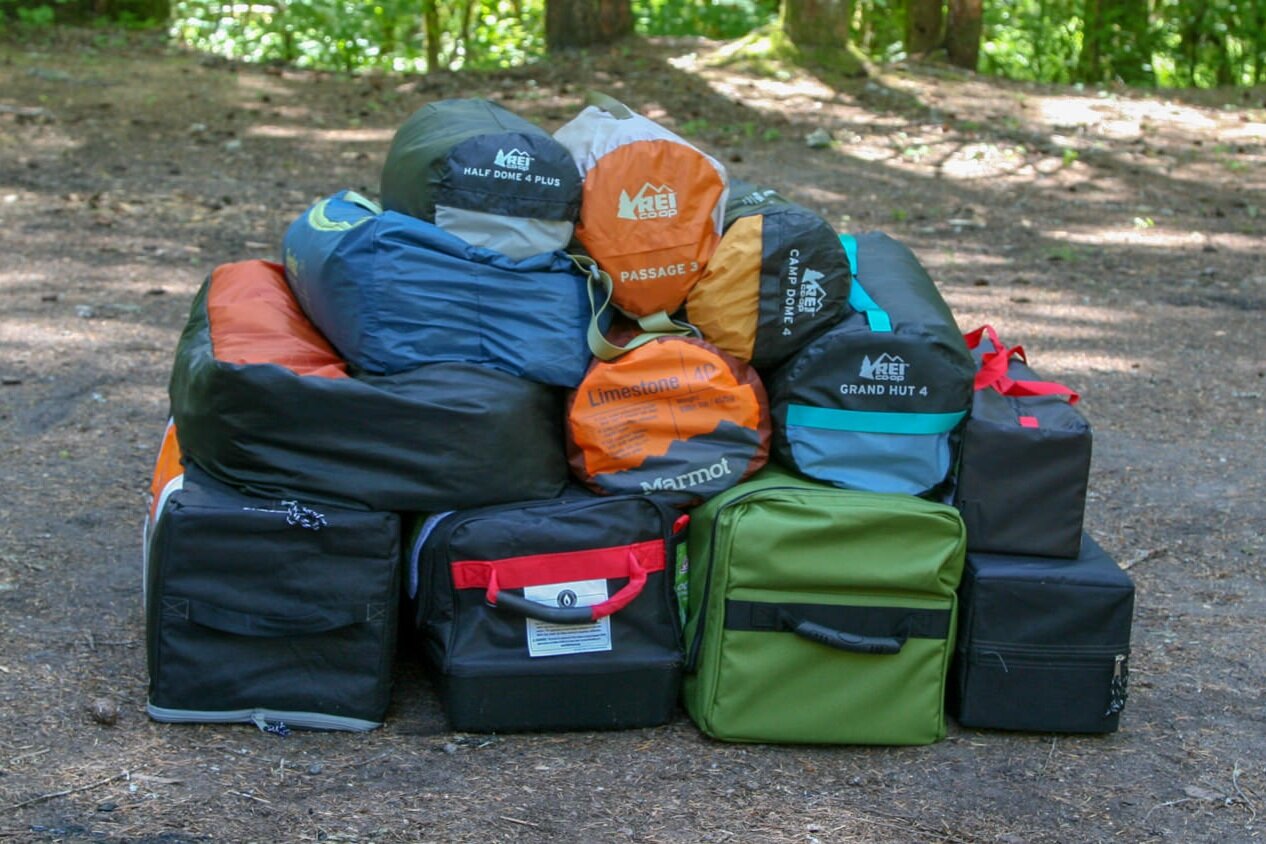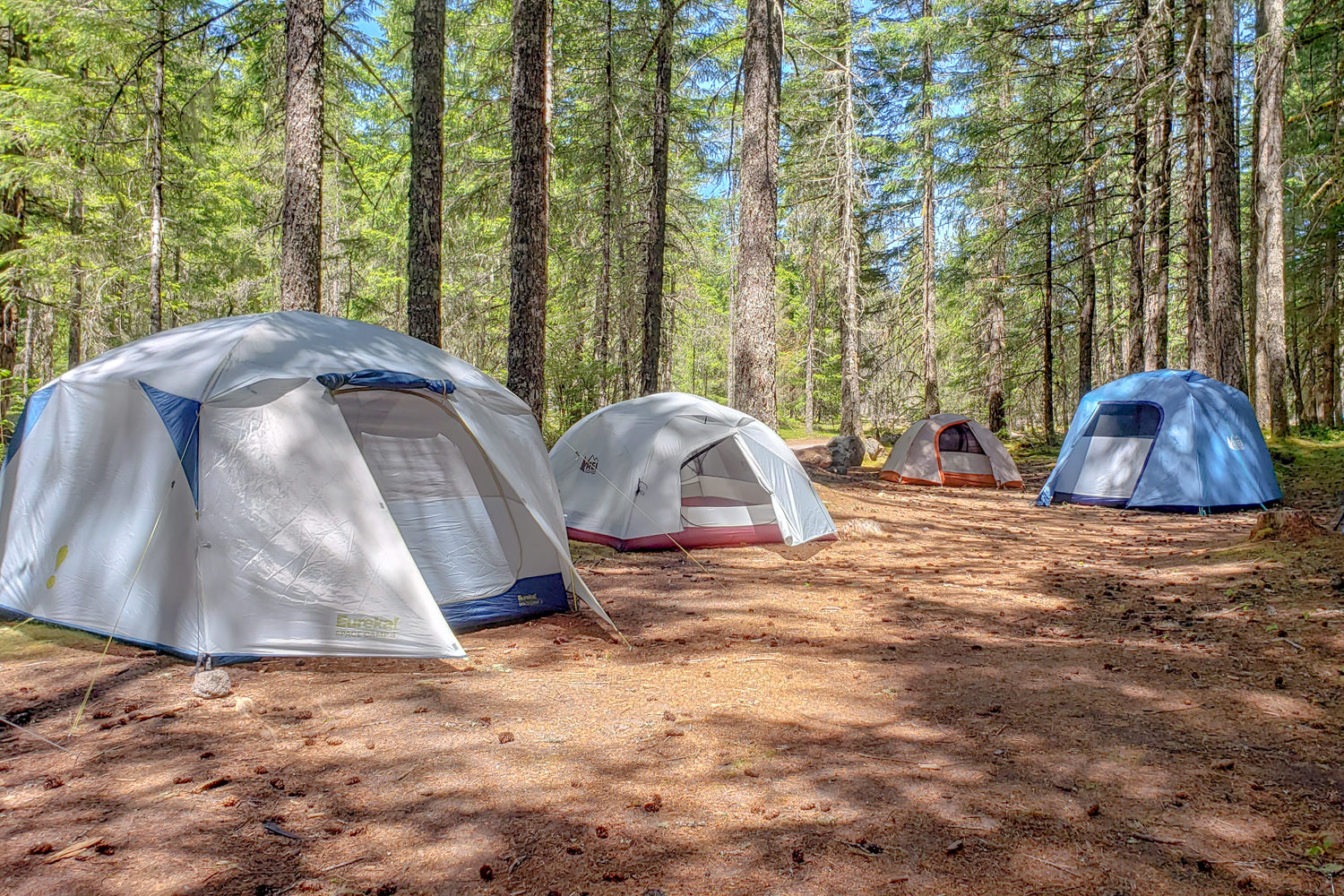Author: Heather Eldridge | Editor: Dave Collins
Last Updated: March 6, 2023
The right camping tent can make all the difference on your vacation. Most of us can conjure a memory of an experience with a lousy tent. A frustrated dad, poles snapping in the wind, cramped quarters, a long wet night. Sound familiar? Fear not! We’re here to help you find a tent that’s easy to set up, spacious, and comfortable to sleep in.
When you’re in the market for a new tent, you’ll quickly find there are A LOT of options out there. We spent countless hours researching and testing to narrow this list down to the very best of the best.
The REI Skyward 4 is spacious, easy to setup & relatively compact
Quick Recommendations
Check out this quick list of our favorite camping tents, or continue scrolling to see our full list with in-depth reviews.
Best camping tent for all-around value: REI Skyward 4
Best luxury camping tent: REI Wonderland 4
Best crossover choice for camping & backpacking: REI Half Dome SL 2+ & 3+
Comfy tent with nearly vertical walls & great ventilation: Eureka Space Camp 4
Best luxurious budget camping tent: Coleman Octagon 98
Most Affordable Crossover Tent for Backpacking & Car Camping: REI Trail Hut 2
Easy to set up & made with high-quality materials: NEMO Aurora Highrise 4
Simple camping tent with quick & easy set up: Caddis Rapid 6
Simple budget tent with a partial rainfly: Coleman Sundome 4
The REI Half Dome has a ton of useful storage pockets & plenty of space for a couple or small family
What’s Most Important to You in a camping tent?
PRICE - Camping tents can be pretty expensive; some of our favorites cost as much as $600. But don’t fret, your front-country castle doesn’t need to cost an arm and a leg for you to have a great time. Below, we recommend camping tents at a variety of price points to get you out there.
Best value camping tents: REI Skyward Tents, REI Half Dome SL 2+ / 3+, Coleman Octagon 98 & NEMO Aurora Highrise Tents
Best luxury camping tent: REI Wonderland Tents
Best budget camping tents: REI Trail Hut 2 & Coleman Sundome 4
One of our favorite things about the NEMO Aurora Highrise Tent is that is has windows all the way around for views
VERSATILITY - Some people like having a tent for each type of activity, others want one tent that can do it all. Tents that fit into this category are great for a range of activities, including backcountry trekking and front-country camping.
Tents that could work for both camping & backpacking: REI Half Dome SL 2+ / 3+, Big Agnes Copper Spur HV UL Series, MSR Hubba Series, Marmot Tungsten UL Series & REI Trail Hut 2
The REI Wonderland is the next generation of the popular Kingdom - it’s incredibly spacious & has plenty of headroom
SPACE - You’ll want to have an idea of how many people will typically be sleeping in your tent and if you want the ability to stand up inside. It’s usually a good idea to size up with camping tents (ex: get a 4-person tent to sleep 2-3 people) because manufacturers typically overestimate how many people can comfortably sleep in them.
Most spacious camping tents: REI Wonderland Tents, REI Skyward Tents, Coleman Octagon 98 & Caddis Rapid 6
The Eureka Space Camp 4 feels spacious & luxurious without being overkill for a couple or small family
EASE OF SETUP - Larger tents tend to have a more complicated set up process than small tents, but many of them are still easy to pitch. It’s always a good idea to practice setting your tent up for the first time at home to avoid confusion and frustration on your trip.
Easiest camping tents to set up: REI Skyward Tents, REI Half Dome SL 2+ / 3+, REI Trail Hut Tents, NEMO Aurora Highrise Tents & Caddis Rapid 6
Tents with a symmetrical pole design are easy & intuitive setup
WEIGHT/SIZE - Weight isn’t quite as important for car camping as it is for backpacking, but it’s still nice to have a tent that’s easy to maneuver and doesn't take up a ton of space. If you have a small vehicle, limited storage space at home, or you’ll be venturing a ways away from your car, consider going with one of the lighter/more compact tents.
Best lightweight & compact tents: REI Half Dome SL 2+ & REI Trail Hut 2
Best mid-size/weight tents: REI Skyward 4, Eureka Space Camp 4, REI Trail Hut 4 & NEMO Aurora Highrise 4
Best heavy-duty tents: REI Wonderland 4, Coleman Octagon 98 & Caddis Rapid 6
Best Camping Tents of 2023
BEST CAMPING TENT OVERALL
MSRP: $299
THE SIZE WE TESTED FEELS: Luxurious for 2, comfortable for 3 & tight for 4
PACKED WEIGHT: 13 lbs. 11 oz.
DIMENSIONS (L x W x H): 100 x 87 x 78 in.
PROS: High-quality poles & materials, room to stand, quick/easy set up, large door & vestibule
CONS: Won’t do well in heavy wind due to height (though staking out all guylines helps), guylines not pre-attached
BOTTOM LINE: The REI Skyward is the latest iteration of our longtime favorite camping tent, the Grand Hut. We like the Skyward tent for its high-quality tent poles and fabrics, spacious interior, and ease of setup. It has near-vertical walls and a 6.5 foot peak height, so you can stand, dress, and move around freely. We preferred the Grand Hut’s full-length rainfly, but the Skyward’s cap-style fly that covers the mesh roof is also pretty convenient. The permanent vestibule off the front is also handy, and we like that there’s an awning over the door for drip-free entry. The Skyward is a well-rounded tent with a sweet balance of simplicity, spaciousness, and relatively compact packed size. For more, check out our full review of the Skyward 4.
BEST LUXURY CAMPING TENT
MSRP: $499
THE SIZE WE TESTED FEELS: Luxurious for 2, comfortable for 3 & tight for 4
PACKED WEIGHT: 21 lbs. 11 oz.
DIMENSIONS (L x W x H): 120 x 100 x 75 in.
PROS: Room to stand, high-quality poles & materials, 2 large doors, large vestibule, awnings over doors
CONS: Expensive, won’t do well in heavy wind due to height (though staking out all guylines helps), guylines not pre-attached
BOTTOM LINE: REI’s Wonderland 4 is a redesign of the popular Kingdom Tent. It features a large, open space with a high ceiling, giant doors at both ends, and plenty of convenient storage pockets to keep gear organized. The Wonderland is fully rain-ready with sealed seams, a protected front entryway, and a huge vestibule for storing wet gear. It has a scalloped fly with protected windows all around, so you can see out and have ventilation even if it’s raining. Though this tent is quite large, it’s a manageable weight and fits into a compact case for easy carrying. The Wonderland is a very close second to the REI Skyward on our list, and that’s mostly due to its price. The Wonderland is an excellent and roomy camping tent, and it will last for many years of adventure since it’s built solid with high-quality materials. For more, check out our full review of the Wonderland 4.
BEST CROSSOVER CHOICE FOR CAMPING & BACKPACKING
MSRP: $329
THE SIZES WE TESTED FEEL: Comfortable for 2 or 3
PACKED WEIGHT: 4 lbs. 11.5 oz. (2 plus without footprint)
DIMENSIONS (L x W x H): 90 x 54 x 42 in.
PROS: High-quality poles/materials, quick/easy setup, lightweight, compact, 2 doors/vestibules, smooth zippers, good ventilation, good pockets, footprint included
CONS: A bit expensive, can’t stand up inside, guylines not pre-attached, not enough stakes/guylines
BOTTOM LINE: If you prefer the convenience of a smaller camping tent and you want the option to do some backpacking, consider the REI Half Dome SL 2+ and 3+. Though the Half Dome is not as spacious as some camping tents and you won’t be able to stand up in it, it’s much roomier than the average backpacking tent and it costs a lot less. These tents are more stable in high winds due to their lower profile, they take up less space in your car, and they’re very easy to pitch and take down. The Half Dome is a solid tent that feels comfortable, comes at a great price, and performs well in any weather. For more, check out our full review of the Half Dome SL 2+.
COMFY TENT WITH NEARLY VERTICAL WALLS & GREAT VENTILATION
MSRP: $400
THE SIZE WE TESTED FEELS: Luxurious for 2, comfortable for 3 & tight for 4
PACKED WEIGHT: 13 lbs. 14.4 oz.
DIMENSIONS (L x W x H): 96 x 90 x 68 in.
PROS: Room to stand (under 5’6”), quality poles/materials, 2 large doors/vestibules, smooth zippers, quick/easy setup, includes all guylines & stakes, good ventilation
CONS: A bit expensive, can’t stand up inside (5’7” or taller), won’t do well in heavy wind due to height (though staking out all guylines helps), guylines not pre-attached
BOTTOM LINE: Eureka’s Space Camp 4 is a welcoming shelter with nearly vertical walls and a versatile rainfly. With the rainfly zipped down, there are two generous vestibules to protect your gear when bad weather hits. Three high kickstand vents provide good ventilation and a low vent in the door promotes airflow. The main downside of the Space Camp 4 is that it isn’t quite tall enough to stand up in if you’re over 5’6”, but the Space Camp 6P has a peak height of 6’4” if more headroom is what you’re looking for. The Space Camp is among the highest-quality affordable camping tent options.
BEST LUXURIOUS BUDGET TENT
MSRP: $350 (often on sale for much less)
SIZES AVAILABLE: 8P
THE SIZE WE TESTED FEELS: Luxurious for 4, comfortable for 5 & tight for 6
PACKED WEIGHT: 49 lbs. 5 oz.
DIMENSIONS (L x W x H): 156 x 156 x 82 in.
PROS: Affordable, room to stand, durable, 2 doors (1 with a unique screen door hinge), room divider, includes door mats, includes all guylines & stakes
CONS: Heavy/bulky, no vestibules, storage/organization pockets could be better, no access to vents from inside tent, fairly cumbersome setup & breakdown
BOTTOM LINE: The Coleman Octagon 98 is a unique and affordable shelter with a high ceiling, spacious interior, and window zippers that tie back like curtains for 360° views. A “hinged” front door that swings open makes going in and out of the tent convenient as well. The Octagon is heavier and more cumbersome to set up than some other tents, but it’s not too bad if you have two or more people to help. The structure of the Octagon is solid in the wind if all of its many guy-out points are staked down and secured. All in all, the Octagon is an appealing tent, especially for families or small groups who want to create a luxurious hangout space for a few nights. The Octagon 98 is also available in a less expensive half-fly version.
MOST AFFORDABLE CROSSOVER TENT FOR BACKPACKING & CAR CAMPING
MSRP: $199
PACKED WEIGHT: 5 lb. 15 oz. (including footprint)
DIMENSIONS (L x W x H): 88 x 52 x 40 in.
PROS: Affordable, durable, freestanding, large doors/vestibules, strong zippers, quick/easy to pitch, footprint included
CONS: Heavier/bulkier than some backpacking tents, less headroom than some, not enough stakes/guylines included, guylines not pre-attached
BOTTOM LINE: The affordable REI Trail Hut 2 is a great budget tent for individuals or couples who want a practical camping tent that’s easy to pitch. The Trail Hut is very affordable but has some of the same features more expensive tents have, like two wide doors, double vestibules, and good vents. The Trail Hut 2 is lightweight and compact enough that it could be for backpacking trips (though the Half Dome SL 2+ and 3+ are higher quality overall).
The budget-friendly Trail Hut doesn’t skimp on interior space or quality, so we think it’s an excellent investment for those wanting to get outside without spending a fortune.
If you’re looking to go as affordable as possible, the REI Trailmade 2 costs less and is a bit lighter. Ultimately we prefer the Trail Hut for its larger interior space, but either tent is a solid choice. For more, check out our full review of the Trailmade 2.
EASY TO SET UP & MADE WITH HIGH-QUALITY MATERIALS
MSRP: $400
THE 4P FEELS: Luxurious for 2, comfortable for 3 & tight for 4
PACKED WEIGHT: 15 lbs. 14 oz.
DIMENSIONS (L x W x H): 100 x 90 x 75 in.
PROS: High-quality poles/materials, 2 doors, quick/easy setup, relatively compact
CONS: A bit expensive, half door in the back, stuff sack is a bit tight
BOTTOM LINE: The NEMO Aurora Highrise 4 is a great tent for those wanting something spacious and easy to set up. We love the big door on the front and the fact that you can see out of the windows on all four sides – even when it’s raining. This tent is made with high-quality materials, so it’s ready to rock if a storm comes your way. And it’s plenty durable, so it’ll last for many years if you treat it with care. You can get the bigger Aurora Highrise for the same price as the smaller version of comparable tents, so we think it’s an excellent value. For more, check out our full review of the Aurora Highrise 4.
SIMPLE CAMPING TENT WITH QUICK & EASY SET UP
MSRP: $350
SIZES AVAILABLE: 6P
THE SIZE WE TESTED FEELS: Luxurious for 2, comfortable for 4 & tight for 5+
PACKED WEIGHT: 25 lbs. 8 oz.
DIMENSIONS (L x W x H): 120 x 120 x 80 in.
PROS: Quick/easy set up, room to stand, gear loft, includes all guylines & stakes
CONS: A bit expensive, bulky/heavy, only 1 door, no vestibule, won’t do well in heavy wind due to height (though staking out all guylines helps), zipper snags at times
BOTTOM LINE: The Caddis Rapid 6 has a high ceiling, near-vertical sidewalls, and screened windows on all sides for a cabin-like feel. The Rapid differentiates itself by having pre-attached poles, making set up very fast and easy. Simply unfold the tent, extend the legs, and raise the structure. The Rapid looks a bit frumpy if it’s not staked out, but it’s much tidier once it’s pulled taut. Overall, we found this tent to be sturdy and weatherproof, and the rainfly provides more coverage than many cabin tents. For those whose top priority is easy set up and lots of headroom, the Rapid is a good choice.
SIMPLE BUDGET TENT WITH A PARTIAL RAINFLY
MSRP: $100 (often on sale for less)
SIZES AVAILABLE: 2P, 3P, 4P & 6P
THE SIZE WE TESTED FEELS: Comfortable for 2 & tight for 3 or more
PACKED WEIGHT: 10 lbs. 3 oz.
DIMENSIONS (L x W x H): 108 x 84 x 59 in.
PROS: Affordable, quick/easy set up, relatively lightweight/compact, includes all guylines, stakes & a door mat
CONS: Low-quality poles/materials, not fully seam-taped, can’t stand up inside, limited ventilation, single door, zipper snags at times, no vestibule, weak carrying case
BOTTOM LINE: The Coleman Sundome 4 is a very affordable tent that’s relatively light and compact, and comes in a variety of sizes. It’s popular because it’s so inexpensive (and almost always on sale), but its poles and materials are much lower quality than the other tents on this list. If you just need a simple and cheap tent for a few nights of fair weather camping here or there, the Sundome will do a fine job.
The Marmot Limestone 4P has sturdy, high-quality poles, a roomy interior & a two giant doors for airflow & views
Honorable Mentions
The following camping tents didn’t make our final list, but they’ve still got a lot of good things going for them. You never know, one of them might be perfect for you:
Marmot Limestone 4P - The Limestone is a great, high-quality tent. We love the two giant doors, the stout poles, and the relatively compact packed size. It’s very similar to the Eureka Space Camp 4 and NEMO Aurora Highrise 4.
The Coleman Octagon 98 is affordable & offers lots of space for groups on multiday trips
Critical Camping Tent Considerations
CHOOSING A TENT SIZE - Capacity ratings tend to overstate the number of people (and sleeping pads) that fit in a tent, so it’s best not to rely on that number unless you enjoy sleeping like sardines. A good rule of thumb is to upsize by at least 1 or 2 people for comfort. If you’re tall, claustrophobic, or you share a tent with children or pets, a little extra elbow room will make your trip much more enjoyable. You could also consider using multiple small tents in place of one large tent to accommodate groups. Kids that are old enough will be stoked to have their own tent. If you’re unsure what size will work best for your group, check out our Tent Size Guide.
The REI Skyward 4 has the highest peak height of any of the tents on our list - 78 inches or 6.5 ft.
PEAK HEIGHT - If you’re camping for multiple days and plan to spend a significant amount of time hanging out in your tent, you’ll want to choose one that’s tall enough to stand and move around in. Tents with high peaks and near vertical walls have the most usable space, but they also have more problems in windy conditions. Be sure to use the appropriate stakes and guylines to help support larger tents and avoid issues.
The REI Wonderland 4 Tent has a ton of ventilation & an awesome mesh ceiling for sky views
VENTILATION - Good ventilation is important for controlling internal condensation. Look for tents designed with adequate roof vents that allow fresh air to circulate, rain or shine. It’s not much fun being cooped up in a muggy tent without vents when the weather turns foul. Some tents have zippers that allow you to access top vents with kickstands from the interior of the tent, which comes in handy in tents with high roofs that are hard to reach on the outside. Be sure to stake out the sides of your rainfly for better air circulation.
The REI Half Dome is well ventilated so you can stay comfortable - even during hot days
NUMBER OF DOORS - Having multiple doors is a must for group camping. Being able to enter, exit, and access gear in the vestibules without disturbing each other makes camping trips far more enjoyable. Adequate doorway and vestibule space are key when it’s rainy and everyone wants to clamber into the tent to get out of their wet or dirty clothes as quickly as possible.
The Eureka Space Camp 4 has giant doors on either side, so you can open them up for airflow & views
VESTIBULES & AWNINGS - Vestibules are covered areas meant for protecting and storing gear or shoes outside of your tent. If you plan to camp in places where it rains often, make sure your tent has one or more good vestibules so you won’t have to bring wet or muddy gear inside your sleeping area. Some vestibules can also be converted into awnings for shade using pole accessories (not included). Some campers bring a separate shade or screen house that can be set up away from their tent, while others prefer to use an awning directly attached to their tent like a porch.
The REI Skyward has a permanent vestibule off the front & an awning over the door for drip-free entry
EASE OF SETUP - Setting up any tent for the first time can be challenging, but it gets easier with practice. Many tents are designed to be intuitive and quick to pitch with color-coding, buckle clips, and simple directions. Be sure to choose a tent that’s a manageable size and weight for you to handle easily, especially if you’ll be pitching it alone. Large tents can be awesome, but don’t choose one that’s so complex that it takes all the fun out of camping.
Larger tents can sometimes have a more complicated setup that requires multiple people
WEIGHT- The weight of your camping tent isn’t super critical, but you’ll want to make sure it’s easy enough to tote around without hurting your back. Tents under four pounds are more ideal for backpacking; check out our Best Backpacking Tents list to see our favorites.
camping tents vary in size from compact & light to heavy & bulky
PACKED SIZE - The packed size of your tent is much more important for backpacking, but it’s smart to consider how much space you’ll have for your camping gear in your car and storage space at home. A compact tent will be far less cumbersome to maneuver.
SEASON RATINGS
3-Season Tents - 3-Season tents are the most common type of tent and are typically meant to be used during the summer months when the weather is fair. These tents tend to have good ventilation and will protect you from rain and insects, but they may not be robust enough to withstand storms with heavy rain or high winds.
3-4 Season Tents - Some 3-season tents can be used from early spring through late fall. They’re designed with more weather protection in mind and seek to offer a balance of ventilation, strength, and heat retention. These tents are often dome-shaped to shed rain and light snow with slightly more robust poles to give the structure rigidity to withstand winds. The rain fly will usually be more full-coverage and extend almost to ground with one or more vestibules to keep gear and shoes dry.
4-Season Tents - 4-season tents are best for those who plan to camp in snow and inclement weather, but they’re overkill for most 3-season car campers since they’re generally much more heavy and bulky. They tend to have lower-profiles and are more dome-shaped to shed snow and high winds. One downside to 4-season tents is that they have a lot less ventilation, which can make the living area too warm and stuffy in summer conditions. 4-season tents are best reserved for winter camping or extended trips in heavy rains when it’s crucial to have a warm, safe shelter.
The Coleman Octagon 98 offers a unique camping experience at an affordable price
Getting the Most Out of Your Tent
FOOTPRINT - If you’re spending a significant amount of money to buy a quality tent, it’s well worth investing in a footprint to extend the life of the fabric. If a specific footprint isn’t available for your tent model, a generic one will do. Just make sure the footprint you get is the right size - a footprint that’s too large can collect water and cause it to pool under your tent. For more information, check out out Do You Really Need a Footprint? post.
USE STAKES & GUYLINES - Fully staking out a tent maximizes interior space, is far sturdier, and looks much more sleek. Spending a few minutes to completely stake down and guy-out your tent could mean the difference between your tent lasting for years, or ripping to shreds in the wind. If your guylines didn’t come pre-attached, the best way to attach them to the rainfly is with a bowline knot. If your tent has a lot of guylines and stake-out points, consider bringing a small mallet to make the staking process quicker and easier. Many camping tents don’t come with enough stakes and guylines for all of the guy-out points, so it’s a good idea to pick up some extra guylines and tent stakes.
WATERPROOFING - Most high-quality tents come fully seam-taped or sealed to stop water from penetrating where the fabric has been stitched. If the instructions tell you to seal all the seams to increase weather protection, that means the tent isn’t storm-proof off the shelf. Seam sealing isn’t difficult, but it can be time-consuming and somewhat tedious on a large tent. If your tent was once seam-taped, but you’ve noticed it starting to leak, it might be time to do some maintenance to extend the life of the tent by sealing the seams, replacing a peeling polyurethane coating, and refreshing the DWR coating on the rainfly.
The NEMO Aurora Highrise is high quality, easy-to-set up & very versatile
Looking for a Different type of tent?
Check out these other CleverHiker Gear Guide tent lists:
10 Best Backpacking Tents - tents for backcountry travelers
6 Best Budget Tents - for those looking for a solid budget-friendly tent
10 Best Ultralight Tents - for those who want to save every ounce possible
10 Best Backpacking Hammocks - for those who like to do things a little differently
8 Best 4-Season Tents - for those who don’t let winter end their backpacking season
The REI Skyward 4 is the New iteration of the Grand Hut (Pictured)
Why Trust Us?
We fully understand how tough it is to find trustworthy gear advice, and that’s one of the main reasons we built CleverHiker. We live for outdoor adventure, and we take these guides very seriously. Here are some of the reasons you can trust us:
Our choices are completely independent and based on personal experience.
We’ve logged over 10,000 trail miles and test outdoor gear for a living.
We own and field test every product we recommend, which is sadly not the norm.
We travel to industry trade shows to learn about upcoming product innovations.
We constantly update our guides when new products launch.
We treat our recommendations as if they were for our family and friends.
We’re lifelong learners and we’re always open to constructive criticism. If you think we’ve missed a product or got something wrong, we’d love to hear your feedback.
MORE INFORMATION
We hope this guide helps you find the perfect gear for your needs. If you have more questions or a suggestion, we’d love to hear from you! Sign up for our newsletter to stay updated on our latest posts then visit our Facebook page and Instagram to join the community conversation.
If you found this guide helpful, please give it a share on social media! Also, be sure to check out our CleverHiker Gear Guide to see all of our top gear picks.
Thanks for reading and happy trails!
Some of the links on this page are affiliate links, which means we may receive a modest commission if purchases are made through those links. This adds no cost to our readers and helps us keep our site up and running. Our reputation is our most important asset, which is why we only provide completely honest and unbiased recommendations.

